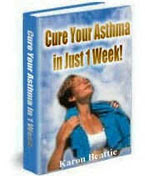Normally when you inhale, air passes easily from your nose and mouth into the trachea, which branches into the two bronchial tubes, or bronchi, that feed the right and left lungs. These primary bronchi divide into smaller and smaller branches, or segmented bronchi, ultimately narrowing into small stems called bronchioles that terminate in microscopic sacs, or alveoli. These tiny sacs cluster around the bronchioles in a configuration that resembles bunches of grapes
With each intake of breath, your airways dilate and the alveoli expand to admit air, providing oxygen to networks of tiny blood vessels in the alveolar walls. Exhale, and the alveoli shrink, forcing exhaled gas — and with it, carbon dioxide — into the bronchioles, back through the bronchi and trachea, and out of your body.
If you have asthma, much of the time your airways are fully open, and at those times you can breathe normally. At other times, however, your airways become constricted and breathing becomes difficult, so bad at times that you may feel as though you are trying to breathe through a straw while a gorilla sits on your chest.
The variable narrowing of the breathing tubes that can come and go over a period of minutes, hours, or days is called reversible airway narrowing and is one of the hallmarks of asthma. This variability distinguishes asthma from other lung diseases, such as emphysema and chronic bronchitis, which cause permanent breathing problems that occur day in and day out.
Airways narrow in asthma because they are hypersensitive, or — to use a less medical-sounding term — "twitchy." Having twitchy airways doesn’t mean that they feel twitchy; it means that there is an underlying tendency for the airways to react by narrowing when they encounter certain stimuli, such as cat dander or cold air. These stimuli are known as asthma triggers, because they cause symptoms to flare up (see Asthma Triggers). If you have asthma, the potential for airway narrowing is always there: Your airways remain hypersensitive or "twitchy" even when you feel well. Asthma thus involves intermittent airway narrowing but persistent vulnerability to that narrowing — a concept that is central to both the understanding of this disorder and its treatment.
Wednesday, February 4, 2009
Subscribe to:
Post Comments (Atom)

No comments:
Post a Comment